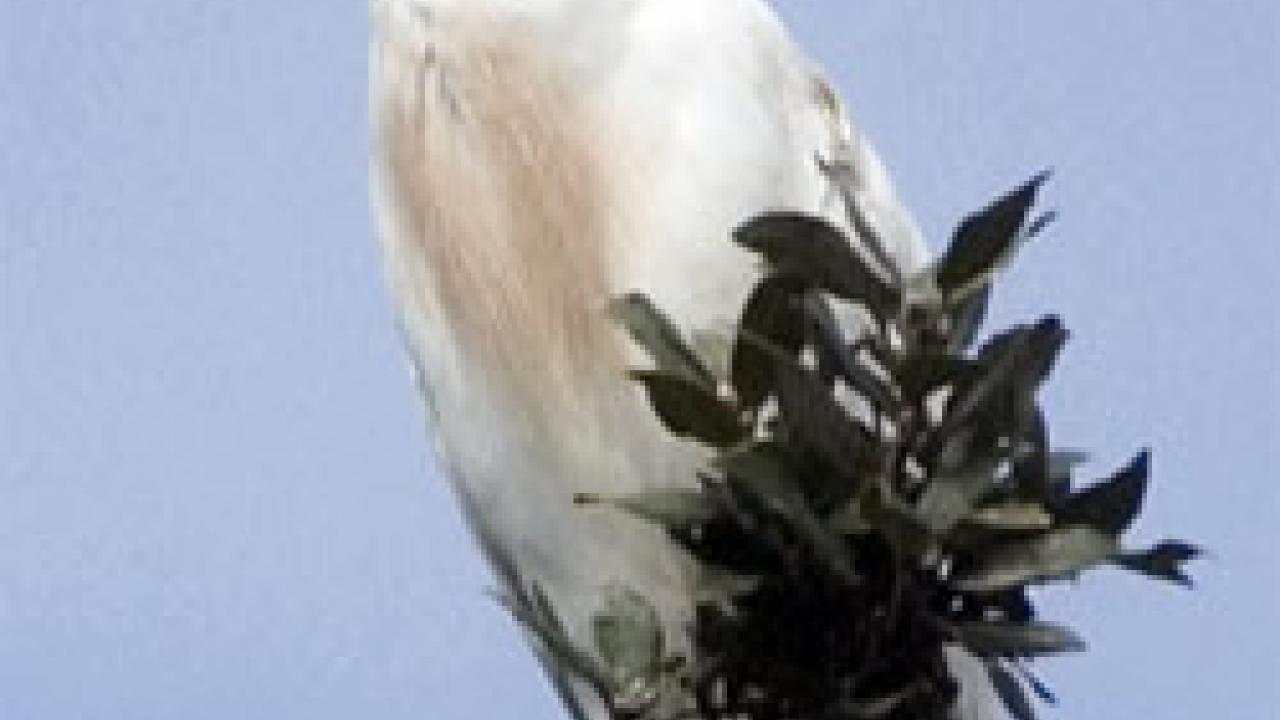A program to discourage egrets and herons from nesting in the campus's Shields Oak Grove will continue next year with a bit more flash.
When the first black-crowned night-herons arrive in March, they will be greeted with disturbing but harmless distress calls and laser lights, said Ellen Zagory, director of horticulture for the UC Davis Arboretum and a member of the arboretum oak and wildlife management team.
The annoyances will persist, at dusk and dawn, as long as the big birds continue landing in the oak trees. Based on the annual pattern seen in the eight years since the first nests were built, the team expects to have to shoo away two overlapping waves of birds -- night-herons, snowy egrets and great egrets followed by a large and prolonged wave of cattle egrets.
The Shields Oak Grove was established at the arboretum's west end in 1963. The big, wading birds began using the trees as a rookery — a place to nest and raise offspring — in 2000. Since then, their nests have become more numerous and spread over a larger area of the grove. In 2006, there were 631 nests; in 2008, there were 866 nests.
In addition to the rookery, the Shields Grove has also become a roost for non-nesting birds during the breeding season. While the rookery numbers have steadily risen, the roost numbers fluctuate widely, for unknown reasons. In 2007, there were 800 birds simply roosting in the grove; in 2008, there were only a handful.
What began as an interesting wildlife spectacle has become a serious threat to the oak trees' health, largely because of the toxic qualities of the birds' excrement, or guano, Zagory has said.
"Ammonia is toxic and causes defoliation. Guano is opaque, so it blocks photosynthesis and causes defoliation. Salts stunt the growth of roots and shoots, and cause margin burn on the leaves and defoliation," Zagory summed up the problem last spring.
Complete defoliation of a branch over several years kills the branch. Dead branches can lead to weak and dying trees -- not an option for the oak grove, which is a resource for scholars and conservationists, as well as recreational visitors. It contains the largest collection of mature oaks in the southwestern United States -- 304 trees representing 87 types of oak species, varieties and hybrids, some of which are rare and endangered. It is a partner in the national oak collection of the prestigious North American Plant Collections Consortium.
In past years, in hopes of a sustainable balance for both trees and birds, the arboretum oak and wildlife management team has tested a variety of nesting deterrents: structural pruning of trees; removing some redundant and crowding trees; removing the remnants of previous years' nests; and tying shiny Mylar streamers and balloons to the treetops.
The rookery kept growing, although last year's trial with a hand-held laser light was very effective in moving birds away from a selected grove of trees, said Andy Engilis, curator of the UC Davis Museum of Wildlife and Fish Biology, and the wild-bird expert on the team.
"No single method alone has been shown to be effective in deterring colonial-nesting birds, so we need to throw a suite of tactics at them," said Engilis. "This year, we will use laser lights in combination with bird distress calls broadcast from loudspeakers, human presence and even, possibly, small noisemaking fireworks."
If any birds are resolute enough to lay eggs, the entire deterrent program will stop, in order to prevent any chick deaths, Engilis said.
"The keys to success will be diversity of methods, timing, persistence and organization," he concluded. "The university is committed to finding a solution that works for both birds and trees. We are hopeful that this season we have the right formula."
About UC Davis
For 100 years, UC Davis has engaged in teaching, research and public service that matter to California and transform the world. Located close to the state capital, UC Davis has 31,000 students, an annual research budget that exceeds $500 million, a comprehensive health system and 13 specialized research centers. The university offers interdisciplinary graduate study and more than 100 undergraduate majors in four colleges — Agricultural and Environmental Sciences, Biological Sciences, Engineering, and Letters and Science — and advanced degrees from five professional schools: Education, Law, Management, Medicine, and Veterinary Medicine. The UC Davis School of Medicine and UC Davis Medical Center are located on the Sacramento campus near downtown.
Media Resources
Ellen Zagory, Arboretum, (530) 752-3145, emzagory@ucdavis.edu
Andy Engilis, Museum of Wildlife and Fish Biology, (530) 752-0364, aengilisjr@ucdavis.edu
